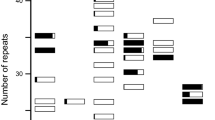Summary
Apomixis is widely distributed among tropical forage grasses, and has long been merely regarded as an impediment to breeding. Panicum maximum is presented as the first opportunity for Brazilian geneticists to develop and test original breeding schemes adapted to an apomictic species.
A large and representative germplasm of P. maximum has been introduced and is currently being evaluated. Basic knowledges on biology and reproduction are also available, which demonstrate an easy manipulation of apomixis and sexuality. Several limiting traits have already been detected during evaluation, which justify breeding attempts. An ideal scheme is given to transfer new qualities to already selected varieties.
Similar content being viewed by others
References
Bashaw, W.C., 1968. Registration of Higgins buffelgrass. Crop. Sci., 8: 397–398.
Bashaw, E.C., 1975. Problems and possibilities of apomixis in the improvement of tropical forage grasses. In: Tropical Forages in Livestock Production Systems. ASA special publ., 24: 23–30.
Bashaw, E.C., 1980. Registration of Nueces and Llano buffelgrass. Crop. Sci., 20: 112.
Brown, W.V. & W.H.P. Emery, 1958. Apomixis in the Graminese: Panicoidese. Amer. J. Bot., 45: 253–263.
Burton, G.W., 1947. Breeding bermudagrass for the southeastern United States. J. Am. Soc. Agron., 39: 551–569.
Burton, G.W., 1972. Registration of Coastcross-1 Bermudagrass. Crop. Sci., 12: 125.
Burton, G.W. & W.G. Monson, 1978. Registration of Tifton 44 Bermudagrass. Crop. Sci., 18: 911.
Cameron, D.F., 1983. To breed or not to breed. In: J.G. McIvor & R.A. Bray (Eds), Genetic resources of forage plants. CSI-RO, East Melbourne, pp. 237–250.
Chase, A., 1944. Grasses of Brazil and Venezuela. Agr. in the Amer. 4: 123–126.
Chaume, R., 1985. Organization de la variabilité génétique du complexe agamique Panicum maximum en vue de son utilisation en amélioration des plantes. Travaux et Documents ORSTOM 184. ORSTOM, Paris, 243pp.
Combes, D., 1975. Polymorphisme et modes de reproduction dans la section des Maximae du genre Panicum (Graminées) en Afrique. Mémoires ORSTOM 77. ORSTOM, Paris, 99p.
Combes, D. & J. Pernes, 1970. Variations dans les nombres chromosomiques du Panicum maximum Jacq. en relation avec le mode de reproduction. C.R. Acad. Sci. Paris, 270: 782–785.
Darlington, C.D., 1939. The evolution of genetic systems. Cambridge Univ. Press.
Hanna, W.W., J.B. Powell, J.C. Millot & G.W. Burton, 1973. Cytology of obligate sexual plants in Panicum maximum Jacq. and their use in controlled hybrids. Crop. Sci., 13: 965–697.
Harlan, J.R., M.H. Brooks, D.S. Borgaonkar & J.M.J. de Wet, 1964. Nature and inheritance of apomixis in Bothriochloa and Dichanthium. Bot. Gaz. 125: 41–46.
Nakajima, K., M. Ochi & N. Mochizuki, 1978. Characteristics and variations of guineagrass strains collected and introduced from Africa. I. Evaluation of characteristics and variations. Bull. Nat. Grassl. Res. Inst. Japan, 12: 38–53.
Nakajima, K. & N. Mochizuki, 1981. Degree of sexuality in sexual plants of guineagrass and their progenies. Japan J. Breed., 31, Suppl. 1: 256–257.
Ndikumana, J., 1985. Etude de l'hybridation entre espéces apomictiques et sexuées dans le genre Brachiaria. These, Univ. of Louvain, Louvain-La-Neuve, Belgium, 210 pp.
Nogler, G.A., 1984. Gametophytic apomixis. In: B.M. Johri (Ed.), Embryology of angiosperm, Springer-Verlag, Berlin, pp. 475–518.
Noirot, M., 1985. The genetic improvement of Panicum maximum Jacq. for the seed production. In: Proc. XV Int. Grassl. Congr., Sci. Council Jap. & Jap. Soc. Grassl. Sci. eds., Jap. Soc. Grassl. Sci. Nishi-nasuno, pp. 260–261.
Noirot, M., J.L. Messager, B. Dubos, M. Miquel & O. Lavorez, 1986. La production grainière des nouvelles variétés de Panicum maximum selectionnées en Côte d'Ivoire. Fourrages 106: 11–19.
Parsons, J.J., 1972. Spread of African pasture grasses to the American Tropics. J. Range Mgmt. 25: 12–17.
pernes, J., R. Réné-Chaume, J. Réné & Y. Savidan, 1975. Schéma d'amélioration génétique des complexes agamiques du type Panicum. Cah. ORSTOM sér. Biol. 10: 67–75.
Read, J.C. & E.C. Bashaw, 1969. Cytotaxonomic relationship and the role of apomixis in speciation in buffelgrass and birdwoodgrass. Crop. Sci. 9: 805–806.
Savidan, Y.H., 1980. [genetic control of facultative apomixis and application to breeding Panicum maximum] (in Russian). In: D.F. Retrov (Ed.), Mutagenesis and apomixis. Sib. Div. Acad. Sci. USSR, Novosibirsk, pp. 96–101.
Savidan, Y.H., 1982a. Nature et hérédité de l'apomixie chez Panicum maximum Jacq. Travaux et Documents ORSTOM 153. ORSTOM, Paris, pp. 159.
Savidan, Y.H., 1982b. Embryological analysis of facultative apomixis in Panicum maximum. Crop. Sci. 22: 467–469.
Savidan, Y.H., 1983. Genetics and utilization of apomixis for the improvement of guineagrass (Panicum maximum Jacq.). In: J.A. Smith & V.W. Hays, (Eds.) Proc. XIV Int. Grassl. Congr., Westview Press, Boulder, pp. 182–184.
Savidan, Y.H., 1986. Apomixis as a new tool to increase grain crop productions in semi-arid tropics—a research project. Agric. Ecosyst. Environment 16: 285–290.
Savidan, Y.H., L. Jank, F.H.D. de Souza & A. Boock, 1985. Preliminary evaluation of Panicum maximum germplasm in Brazil: an international agronomy research program. In: Proc. XV Int. Grassl. Congr., Sci. Council Jap. and Jap. Soc. Grassl. Sci. Eds., Jap. Soc. Grassl. Sci., Nishi-nasuno, pp. 117–118.
Smith, R.L., 1972. Sexual reproduction in Panicum maximum Jacq. Crop. Sci. 12: 624–627.
Smith, R.L., 1975. Breeding Panicum maximum Jacq. Proc. Soil and Crop Sci. Soc. Florida 34: 103–106.
Taliaferro, C.M. & E.C. Bashaw, 1966. Inheritance and control of obligate apomixis in breeding buffelgrass, Pennisetum ciliare. Crop Sci. 6: 473–476.
Voigt, P.W. & E.C. Bashaw, 1972. Apomixis and sexuality in Eragrostis curvula. Crop Sci. 12: 843–847.
Warmke, H.E., 1954. Apomixis in Panicum maximum. Amer. J. Bot. 41: 5–11.
Author information
Authors and Affiliations
Rights and permissions
About this article
Cite this article
Savidan, Y.H., Jank, L., Costa, J.C.G. et al. Breeding Panicum maximum in Brazil. 1. Genetic resources, modes of reproduction and breeding procedures. Euphytica 41, 107–112 (1989). https://doi.org/10.1007/BF00022419
Received:
Issue Date:
DOI: https://doi.org/10.1007/BF00022419




